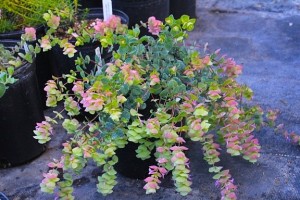 I love oregano—on pizza, in cooked dishes, in salads and in my garden. In the past I have grown pots of common oregano or Origanum vulgare ssp, hirtum to provide myself with ample quantities to dry for winter cooking. This year I will do that once again. The flavor of home grown dried oregano is much better than that of the desiccated contents of the little spice bottles stashed away in kitchens across North America and elsewhere.
I love oregano—on pizza, in cooked dishes, in salads and in my garden. In the past I have grown pots of common oregano or Origanum vulgare ssp, hirtum to provide myself with ample quantities to dry for winter cooking. This year I will do that once again. The flavor of home grown dried oregano is much better than that of the desiccated contents of the little spice bottles stashed away in kitchens across North America and elsewhere.
My love affair with oregano broadened out recently when I bought a single specimen of ‘Barbara Tingey’ a hybrid variety that is grown for its ornamental rather than culinary or medicinal qualities. This oregano, resulting from the cross breeding of at least two species, is one of nature’s imposters, featuring showy arrays of bracts that look like hops. Growing only six to 12 inches tall, with a trailing habit, the bracts are pale green shading to pink. If this sounds like a preppy outfit in plant form, rest assured that the colors are soft and subtle. The bracts are not fly-by-night displays, but last throughout the growing season. The plants also sprout soft, fuzzy true leaves with the characteristic oregano fragrance.
I suppose that you could dry those fuzzy leaves, but I think it is best to let them stay on the plant and invest in a less-flashy culinary oregano variety to supply your pantry.
The craze for ornamental oreganos with hop-like bracts began back at least 20 years ago with ‘Kent Beauty’, the offspring of two species, Origanum rotundifolium, native to Turkey, Armenia and Georgia, and Origanum scabrum, known as “Greek oregano”, for its place of origin. The original plant was a naturally occurring hybrid, found growing in a garden near plantings of both parent species. ‘Kent Beauty’ has whorled, hop-like bracts that some sources describe as pale green shading to mauve. This sounds romantic, but in my experience, the mauve is closer to pink. The discrepancy most likely results from differences in soil chemistry, sun exposure and, possibly, the color reproduction quality of available photographs.
One source describes my ‘Barbara Tingey’ as a “half sister” of ‘Kent Beauty’. Familial relationships in the plant world can be just as complicated as those in the human sphere, but the two varieties do share Origanum rotundifolium parentage. ‘Barbara’ has the same low-growing, sprawling or cascading habit as ‘Kent Beauty’ and the colorful bracts appear to have a brighter pink color. In cold winter climates both varieties should be treated as annuals. In warm winter climates ‘Kent Beauty’ is evergreen, while ‘Barbara Tingey’ will die back in winter and rise again in spring.
The realm of ornamental oregano with showy bracts is not large—yet—but includes ‘Amethyst Falls’, with pale green bracts that end in small purple flowers. Specialty nurseries also carry ‘Pilgrim’, which features small pink flowers surrounded by purple bracts and blue/green leaves. A little more erect than the other ornamental oreganos, ‘Pilgrim’ grows to about 12 inches tall.
As Mediterranean plants, the oreganos share a need for copious sunshine and well drained soil. When ‘Barbara Tingey’ leaves its small starter pot, I will add some sand to the potting mix to make sure things don’t get too soggy. The flip side of the good drainage coin is the ability to withstand some amount of drought. One caveat for container gardeners—container-grown plants dry out much faster than those planted in garden beds, so watering has to be more consistent.
Ornamental oreganos love rock garden settings, where they can sprawl among the rocks, basking in the sun and retained heat. Hanging baskets and window boxes are also options as long as the sites are sunny. Tall containers that allow the bracts to cascade over the sides, are also excellent for these aromatic plants.
Though ‘Barbara Tingey’ and its ornamental relatives don’t resemble mints, they are members of the very large mint or Lamiaceae family. ‘Kent Beauty’ has inherited the minty trait of spreading by underground runners, while ‘Barbara Tingey’ does not. If you are treating the plants as annuals, you don’t have to worry about excessive sprawl. Likewise if you live in a warm winter climate and have space to fill.
If my ‘Barbara Tingey’ plant takes off, I will also cut some of the bracts and dry them for winter arrangements. They retain color well and will keep me in step with the fashion-forward decorators and flower arrangers who are completely infatuated with dried flowers right now.
Deer, who are connoisseurs of plant tastiness, if not plant beauty, tend to avoid oregano, as they do with other mints. I may position my pot of ‘Barbara Tingey’ near a rosebush as part of my unending campaign to confuse Mr. Antlers and his harem.
Large, well-stocked garden centers may carry ‘Kent Beauty’, and some may also have ‘Barbara Tingey’.
You can also find ‘Barbara Tingey’ at Select Seeds, 180 Stickney Hill Road, Union, CT 06076; (800) 684-0395; www.selectseeds.com. Print catalog available. Purchase ‘Kent Beauty’ and/or ’Amethyst Falls’ from Digging Dog Nursery, 31101 Middle Ridge Road, Albion, CA 95410; (707) 937-1235;www.diggingdog.com. Print catalog available.
